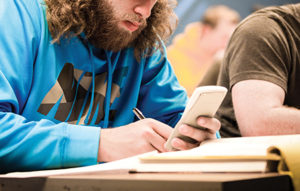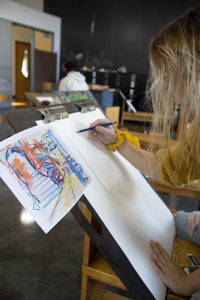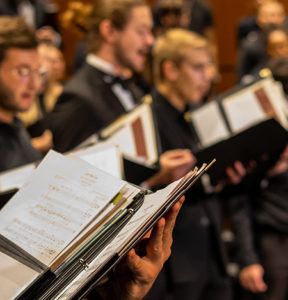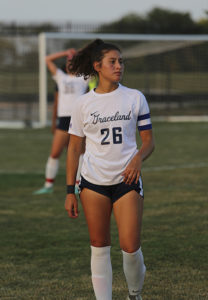From innovative courses designed to prepare students for the modern world to foundational lessons that have served as jumping-off points to self-discovery and deliberation, Graceland students are learning. The campuses have changed, the courses have evolved to meet the needs of contemporary times, and over the years, faculty have come and gone, leaving their own legacy among Graceland students. Follow along for a peek into the exciting classes, social activities, and extracurriculars that are available to a Graceland student today. Some things may feel the same, and others will be surprisingly different, but one thing remains the same: learning is at the center of it all.
……..
8 a.m.
Resch 104
CALCULUS I
Jason Smith, PhD / Assistant Professor of Mathematics

Graceland University, classroom
Students squint as their eyes adjust to the bright lights. The class is quiet as the reality of an 8 a.m. Calculus course hits them after a long weekend.
8:00 Professor Jason Smith asks, “Do we have any questions about our online quiz?” Any specific questions, or should we make one up?
8:01 Kyle Muñoz ‘23 raises his hand and asks to work on: Find f’(x), given f(x): f(x)=(3x+2)6(2×2+5)5 / √x
8:04 Kyle and Dr. Smith go back and forth as the professor guides them through the equation.
8:10 “Do we have any other questions from the homework quiz?” asks Dr. Smith as he erases all of their hard work from the whiteboard.
8:18 The class moves on to a new equation to find the tangent line to f(x) = 4×2-3x+1 with x=3. “Take 30 seconds to work on this problem on your own, and then we’ll review,” states Dr. Smith as he walks around the classroom peering over his students’ shoulders, double-checking their work.
8:25 The morning sun’s light shines through the back window as Dr. Smith and the class review for their test on Wednesday. Students flip their workbooks to start a new notes page, hoping to soak up all possible last-minute information.
8:32 “Maybe we should make a list of the things I expect you to know, so what did we do on day one?” asks Dr. Smith.
8:39 The class lists the different types of limits the students have learned throughout the semester, eventually moving on to continuity review, starting with their basic continuity facts and ending with the Intermediate Value Theorem.
8:50 As students pack up to go to their next class, Dr. Smith reminds them there are practice problems on Brightspace and the quiz from two years ago with the answers for review help.
……..
9 a.m.
Briggs 100
PRINCIPLES OF BUSINESS FINANCE
Ioseb “Soso” Gabelaia, DBA / Assistant Professor of Business
Students are huffing and puffing up the stairs of Briggs, Graceland’s second-oldest building. The conversation is brief and fleeting as friends pass each other in the hall on their way to the next class. Those who are in Principles of Business Finance are grateful they only have to climb one flight of stairs.
8:55 Five minutes until the start of class, and the room is almost empty. Presentations are due today in Professor Gabelaia’s course, and the room is quiet as the fluorescent lights’ gentle hum fills the room. Professor Gabelaia welcomes each student enter Briggs 100, sit down, and pull out their materials for class.
9:00 Harrison Lee ’23 sits down with his reusable Starbucks cup and sighs that he has just made it to class in time. Class starts with a few announcements from the professor as he goes over what is expected from the rest of the class while a team is presenting: “In Brightspace, you will find the assessment form; there are 10 elements you will use to evaluate the presentation team. Everything from audience engagement to professionalism will be evaluated, and the presentation length is expected to be 20-30 minutes.”
9:06 Team three tentatively walks up to the front of the classroom as they get set to present to a room of their peers. Dr. Gabelaia moves to the back of the room to observe the presenters and take notes. The first student opens the presentation and explains they have been set to handle the finances of a famous tennis player.
9:27 The presentation team finishes just above the presentation time minimum. The class goes back and forth, asking the presentation team questions about their case study.
9:46 Gabelaia wraps up class, reminding team four that they will present next Friday, and announces to the students that there is a test on Wednesday. He jovially hints that he might provide some questions that would be good to keep in mind heading into the test, and ends the class with a wink.
“Once I was in the shoes of the students here, and now I am in the same setting but I am leading the classes and using the experience I received as a student here at Graceland on the other side of academia.”
–Ioseb Gabelaia, DBA, ’10
……..
10 a.m.
Helene E205
INTRO TO DRAWING
Karen Gergely, MFA / Associate Professor of Art

9:58 Professor Gergely welcomes students as they enter the classroom and move to their drawing stations.
10:00 Class begins, and students open their sketchbooks to their previous homework assignments. Last week they were asked to review 30 artists’ work from a list of 75 artists and then select two pieces of art to recreate in their sketchbook in less than five minutes.
10:03 Gergely invites students to the front of the classroom for a quick check-in and review of the demonstration from last week.
10:10 Students who were previously absent meet at the front of the class and learn how to rip paper using a ruler to guide the tear. Gergely explains that they tear the paper to recreate the deckled edge look, which makes the paper edge appear nicer than just the regular poster board available at the dollar store.
10:24 Gergely moves around the classroom, pulling up a chair to each student and asking about their project. The whole class draws quietly as peaceful music plays in the background.
10:40 Students gather around for a graphite demonstration as Professor Gergely dips a brush into a jar of powdered graphite and brushes the powder against a blank piece of paper. Gergely explains that powdered graphite is a good option for a dark background: “This covers large areas quickly. I’ll leave this out for you all to play with if you want to add it to your project,” says Gergely.
10:45 Students scramble to get a few minutes of sketching in before packing up and moving on to their next class.
10:50 Gergely reminds students that the goal is to have their drawings ready by Monday.
……..
11 a.m.
Resch 105
BIOCHEMISTRY WITH LAB
Mary Shawgo, PhD /Professor of Biology
Returning to Resch for an 11 a.m. course, students’ eyes are brighter, and everyone appears primed for learning. Dr. Mary Shawgo is renowned for her rigorous courses.
10:59 Dr. Shawgo chats with students about the Homecoming scavenger hunt the night before and reminisces how she once brought her dog to campus for the scavenger hunt.
11:00 She then asks if students have questions before starting board work. A student asks about antibody structure.
11:03 As the class appears ready to move on to the next activity, Shawgo says, “Grab a card, players, and markers. Try to answer these prompts without your notes. There is a laboratory technique packet and a protein structure packet, and if you want to practice your antibody structures, I have that here as well.”
11:09 Brianna Clark ’24 takes pieces of paper that are cut and drawn to represent parts of the cell and places them on the whiteboard with magnets, using them to explain the cellular process of how a protein gets put into the membrane from memory.
11:19 Samuel Johnson ’24 consults Dr. Shawgo about his construction of the protein to membrane process on the whiteboard.
11:31 Mary Kelly ’23 writes “Production as poly & mono coral antibodies” on the whiteboard and begins to compare and contrast the process. Shawgo walks over to her and helps her categorize her notes by adding specificity, production, and small mutation categories.
11:41 “You have about 10 minutes left; I suggest you grab another card to complete before class ends,” announces Shawgo. Students sigh in agreement, erase their work from the whiteboard, and start again.
11:50 Class ends, and Shawgo announces she has office hours at 9:15 tomorrow morning if students have any last-minute questions before their test on Friday.
……..
12 p.m.
Shaw 153
SHAKESPEARE AND SOCIAL JUSTICE
Meghan Hurley Powell, PhD / Visiting Assistant Professor of English
Classroom innovation looks different in every course, but Shakespeare and Social Justice has taken modernizing curriculum to a new level. Students are bustling with excitement as they enter the classroom, ready to engage with the English playwright in an entirely new way.
11:58 Class plans and the “She’s the Man” movie poster are displayed on the projector, visible as you walk in the room.
12:00 “Okay, we’re going to talk about ‘She’s the Man’ in groups, discuss critical claims people have made about the movie, and how the characters differ from their original depiction in ‘Twelfth Night.’”
12:02 Commotion erupts as five groups are formed across the classroom and assigned different characters.
12:10 Hurley-Powell asks the first group, “How is the Duke portrayed in the original Shakespearian script?” Group one replies that they felt he was whiney in the original play compared to how he was portrayed in the movie (an endearing Channing Tatum who is just looking for love).
12:18 “The movie casts a particular actor with specific physique to push back against cultural assumptions that traditionally masculine men cannot display vulnerable feelings,” says Dr. Hurley-Powell in agreement.
12:22 Clara Cleland-Leighton ’24 points out that all changes made to the Duke were done to make it easier for a modern audience to root for his character.
12:36 Ben Long ’23 explains that the character Olivia is more prominent in the play; in the movie, she is more of a plot device, and her character only adapts as her relationship with men adapt. In the film, Olivia is portrayed as more self-serving than in the play. “Why would they make that change?” asks Hurley-Powell.
12:50 The class ends with a discussion of what role satire can play in advancing social justice.
Shaw Family Auditorium
CHOIR
Sara Blessing, DMA / Director of Choral & Vocal Activities, Assistant Professor of Music

11:58 Students grab their choir folder with their music sheets from the choir practice room and head to the auditorium for rehearsal.
12:01 There is a commotion of voices as students occasionally erupt into song and get ready for rehearsal.
12:05 Dr. Sara Blessing approaches the piano as students gather and immediately begin warmups. She plays scales on the piano and the students sing an annunciation exercise.
12:11 There is an announcement that dress rehearsal has been moved to 7:30 tomorrow night, and then the choir begins with “Prairie Lullaby,” also known as “Home on the Range” by Jacob Narverud.
12:15 Blessing plays the piano and gives vocal cues to the different sections of the choir, all while providing feedback for the singers.
12:20 Blessing asks for full forte (meaning loud), and the students raise their voices in beautiful song. The choir fills the auditorium with an ominous dissonance as they perform Egil Hovland’s “Saul.”
12:40 Blessing talks about the importance of the lyrics the choir is singing in “Double, Double, Toil and Trouble,” composed by Jaako Mäntyjärvi. They are pulled from a classic monologue by three witches known as the Wayward Sisters in Shakespeare’s “Macbeth.”
12:50 The choir ends with a beautiful rendition of “Sogno di Volare” from “To Shiver the Sky” by Christopher Tin, and there is an uproar of conversation as students are dismissed from class.
“I feel like my job is to take something that students already enjoy, like music, and open them to a whole array of experiences within that realm. Often our music is intentionally designed to bring about conversations through a safe and shared experience.”
– Sara Blessing, DMA
……..
2 p.m.
Briggs 203
HISTORY OF TERRORISM
Steve Glazer, PhD / Professor of History
This is a new course in the History curriculum and another example of preparing students for the modern world. Students critically interrogate the varied meanings of the term, the use of the term to delegitimize opponents, and the problematic nature of the concept of terrorism.
1:58 Professor Glazer pulls up the instructions for the second class paper due next Friday, titled “Paper #2: 9/11; Country Music Responds.”
2:00 The classroom is full and quiet as the air conditioner hum fills the room, and students wait for class to begin.
2:05 After taking attendance, Dr. Glazer goes into the details of the paper due. The class is focused on the board as he writes instructions. Glazer states, “You are receiving this paper two weeks in advance; give yourself time to write it and give it the effort it deserves.”
2:10 Professor Glazer pauses to pass out four handouts — lyric sheets to Toby Keith’s “Courtesy of the Red, White, and Blue,” Brooks and Dunn’s “Only in America,” Alan Jackson’s “Where Were You When the World Stopped Turning?,” and Martina McBride’s rendition of “Independence Day.”
2:14 Along with the song lyrics, each sheet has a series of questions that prompt students to analyze these country music stars’ responses to 9/11, to consider what the premises of these songs are, and whether the assumptions of these songs are accurate.
2:20 Glazer explains that Martina McBride’s rendition of “Independence Day” came out years before 2001 and uses some of the same patriotic images in the other country songs, but hers is in response to intimate partner violence. Ask yourself, “Does this change how I interpret the previous songs?” and “Is this more or less patriotic than the others?”
2:30 The class rearranges into small groups to develop a project proposal on a lesser-known terrorist act to research and present. Students exchange contact information and discuss project ideas. Dr. Glazer walks around and consults with groups about their projects.
2:50 Class is dismissed, and students file out of the room, relieved to have finished their final class of the day.
……..
5:30 p.m.
Soccer Practice Fields
SOCCER PRACTICE
Bryan Courtney ʼ98 / Head Soccer Coach

5:30 The women’s soccer team runs a lap around the field and chats about their day’s adventures. They stand in a circle to stretch as Coach Bryan Courtney finishes up with the men’s soccer team on the adjacent practice field. (He is redefining what it means to lead a program by answering the call to coach both the men’s and women’s teams for the 2022 season.)
5:34 They begin with “rondo,” a warmup exercise designed to increase decision-making, ball control, and reaction time.
5:40 Courtney ends the men’s soccer practice, moves to the women’s team, and tells the girls to get a partner and a ball. The team lines up and begins a passing drill to improve the force and accuracy of their passing.
5:54 Half the players put on neon green practice jerseys and move to position around the goal. Starting goalkeeper Jessica Kenward ’26 puts on her gloves and stands in the center of the goalposts. The team begins a defensive drill to practice clearing the ball and pressure-cover balance.
6:16 Courtney gathers the team in the center of the field to talk about improving rapid decision-making and movement surrounding the ball to open passing lanes. They resume the drill as occasional shouts of his coaching fill the air.
6:35 The sky is pink with a beautiful Iowa sunset as practice wraps up, and the team debriefs in the center of the field. They bring it in and end with a “Jackets on three — one, two, three — JACKETS!”
“I came to play soccer, but the inclusiveness of the house system provided an experience for me beyond soccer. I want to facilitate an environment of belonging culture so these students can then have their own unique Graceland Experience.”
– Bryan Courtney ʼ98
……..
7 p.m.
Online
PMHNP FOUNDATIONS — ROLES, ISSUES, ETHICAL, LEGAL PRINCIPLES

Woman working on a laptop
Postgraduate learning can require adaptation to the postgraduate lifestyle. The average nursing shift is 12 hours long, and this online course allows for learning flexibility while providing a high-quality education.
7:00 A nursing student logs onto their online nursing course for the semester. This psychiatric mental health foundations course is taught by Leigh Alexander, who has over 40 years of experience in mental health care. The unit for this week is cognitive behavior therapy.
7:12 As the student scrolls through the unit on Brightspace, they notice a quiz due by midnight on Sunday and a discussion post on Thursday. This is a beginning course for the psychiatric mental health nurse practitioner program.
7:23 The discussion post asks the students to respond to the following scenario: “A client declines oral psychotropics. How can Cognitive Behavioral Therapies help the client with anger management, assertiveness, and shame behavior?”
7:40 Moving on to the assignment for the week, students are asked to create a genogram of three generations of their family, including age, birth order, medical, and emotional history. The purpose of this exercise is to understand where they are coming from so they can better help others.
……..
10 p.m.
Tess Morgan
HOUSE MEETING
Hanthorne

10:00 Hanthorne women gradually enter the lower-level Tess Morgan lounge. Some are in their pajamas, but others look like they’ve just returned from a study session with their backpacks in hand.
10:07 House meeting starts with announcements. The intramural representative shares that IM volleyball started and asks what level team everyone wants to be on.
10:12 The house chaplain announces there is Afterglow, the evening worship service, on Wednesday at 7:30.
10:15 House president Delaney Fox ’24, shares that there will be a house function at the Osceola pumpkin patch on November 12. She has placed an event signup and carpool list by the door.
10:17 Delaney brings out tote bags, paints, and brushes for the house meeting activity. The girls play music, decorate their tote bags, and, one by one, go to bed.
……..
One thing certainly has not changed throughout the years — the Graceland lifestyle is a busy one. While this is a detailed glance into any given day for any Graceland student, it still misses hundreds of moments that make up the Graceland Experience. It is impossible to capture all of the social interactions, laughter, and support from friends, faculty, coaches, and staff that create the unique sense of belongingness we know all too well.
Though buildings and facilities, academic programs and student activities may change over time, the heart of Graceland has never changed. It’s the same unique and special place that our alumni have always known. The place that builds confidence as well as character, that expands horizons and opens opportunities, and prepares strong, self-assured students to make a difference in the world.
Features - Fall 2022
December 22, 2022
With COVID protocols and renovations preventing indoor celebration for...
Features - Fall 2022
December 20, 2022
In 1922, Dean of Women Mrs. Vida Smith initiated...
Features - Fall 2022
December 19, 2022
The lights shined brightly on the Lamoni campus as...